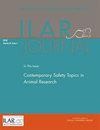研究农业动物和野生动物。
IF 3.1
3区 农林科学
Q1 VETERINARY SCIENCES
引用次数: 11
摘要
在2016财年,猪、绵羊、山羊和牛等农业动物占美国农业部监管研究中使用的820 812只动物的10%。除了传统的农业动物外,随着人类和牲畜种群的入侵,从而扩大了与景观上野生动物种群的相互作用,使用圈养野生动物的研究变得越来越重要。在研究环境中,家畜和圈养野生动物的最佳保健需要适当的饲养、管理和兽医护理。无论何种动物,适当的护理和管理对动物健康、有效的研究数据以及动物护理人员的健康和安全都至关重要。在研究中使用野生动物带来了独特的挑战,因为在野生动物福利、饲养和营养方面的同行评议研究通常有限。动物在搬运或运输过程中经常变得兴奋,必须小心避免受伤。当严重的伤害确实发生时,安乐死的方法可能存在差异。许多野生动物在进化过程中会隐藏疾病的迹象,这使得评估它们的状况变得困难;此外,主治兽医在照顾野生动物方面的经验往往不如照顾传统实验动物或牲畜的经验丰富。在野生动物实地研究的背景下,这些差异被进一步放大。替代、减少和改进的概念在牲畜和野生动物研究中与在生物医学研究中一样有效,研究人员应该与他们的机构动物护理和使用委员会密切合作,以确保人道的动物护理。机构动物护理和使用委员会在提供与研究动物受试者的伦理使用相关的指导方针方面具有核心重要性,并且可以作为研究问责制的宝贵资源。本文章由计算机程序翻译,如有差异,请以英文原文为准。
Research with Agricultural Animals and Wildlife.
In fiscal year 2016, agricultural animals such as swine, sheep, goats, and cattle represented 10% of the 820 812 animals used in USDA-regulated research. In addition to traditional agricultural animals, research studies using captive wildlife are becoming increasingly important as human and livestock populations encroach upon, and thus expand interactions with, wildlife populations on the landscape. Optimum healthcare of both livestock and captive wildlife in a research setting requires proper husbandry, management, and veterinary care. Regardless of animal species, proper care and management are essential for animal well-being, valid research data, and the health and safety of animal care personnel. Using wildlife in research presents unique challenges as there is generally limited peer-reviewed research on wildlife welfare, husbandry, and nutrition. Animals often become excited during handling or transport, and care must be taken to avoid injury. When severe injuries do occur, differences may exist in methods of euthanasia. Many wildlife species are evolutionarily programmed to conceal signs of illness, making assessment of their condition difficult; moreover, attending veterinarians are often not as experienced in the care of wildlife as they are in the care of traditional laboratory animals or livestock. These differences are further magnified in the context of wildlife field research. The concepts of replace, reduce, and refine are as valid in livestock and wildlife research as in biomedical research, and investigators should work closely with their Institutional Animal Care and Use Committees to ensure humane animal care. The Institutional Animal Care and Use Committee is centrally important in providing guidelines relative to ethical use of animal subjects for research and can serve as a valuable resource for research accountability.
求助全文
通过发布文献求助,成功后即可免费获取论文全文。
去求助
来源期刊

Ilar Journal
农林科学-兽医学
CiteScore
5.10
自引率
20.00%
发文量
8
审稿时长
>18 weeks
期刊介绍:
The ILAR Journal is the peer-reviewed, theme-oriented publication of the Institute for Laboratory Animal Research (ILAR), which provides timely information for all who study, use, care for, and oversee the use of animals in research. The journal publishes original articles that review research on animals either as direct subjects or as surrogates for humans. According to policy, any previously unpublished animal research reported in the ILAR Journal will have been conducted according to the scientific, technical, and humanely appropriate guidelines current at the time the research was conducted in accordance with the Guide for the Care and Use of Laboratory Animals or other guidance provided by taxonomically-oriented professional societies (e.g., American Society of Mammalogy) as referenced in the Guide.
 求助内容:
求助内容: 应助结果提醒方式:
应助结果提醒方式:


